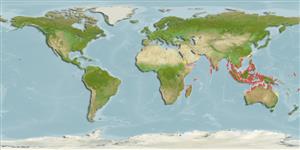Classification / Names
Common names from other countries
Main reference
Size / Weight / Age
Max length : 3.0 cm SL male/unsexed; (Ref. 27223)
Environment
Marine; reef-associated; depth range 1 - 25 m (Ref. 27223)
Climate / Range
Tropical, preferred ?
Distribution
Indo-West Pacific: East Africa to Papua New Guinea and the Solomon Islands, north to Taiwan.
Countries | FAO areas | Ecosystems | Occurrences | Introductions
Short description
Dorsal
spines
(total): 14 - 16;
Dorsal
soft rays
(total): 9-11;
Anal
spines: 1;
Anal
soft rays: 17. Pectoral-fin rays 15-16, at least some branched; caudal peduncle with distinct dark bar or marking; body with well defined vertical or oblique dark bars; pored lateral-line scales 13-16 (usually 15-16); anal fin rays 17; body bars oblique; second dorsal fin without black spot; caudal peduncle bar narrow, lying at base of caudal peduncle; anal fin with 6-7 dark basal spots, which are dark blue in life.
IUCN Red List Status (Ref. 115185)
Threat to humans
Harmless
Human uses
More information
Age/SizeGrowthLength-weightLength-lengthLength-frequenciesMorphometricsMorphologyLarvaeLarval dynamicsRecruitmentAbundance
ReferencesAquacultureAquaculture profileStrainsGeneticsAllele frequenciesHeritabilityDiseasesProcessingMass conversion
Tools
Special reports
Download XML
Internet sources
Estimates of some properties based on models
Phylogenetic diversity index
PD50 = 0.5000 many relatives (e.g. carps) 0.5 - 2.0 few relatives (e.g. lungfishes)
Trophic Level
3.1 ±0.3 se; Based on size and trophs of closest relatives
Resilience
High, minimum population doubling time less than 15 months (Preliminary K or Fecundity.)
Vulnerability
Low vulnerability (10 of 100)
Price category
